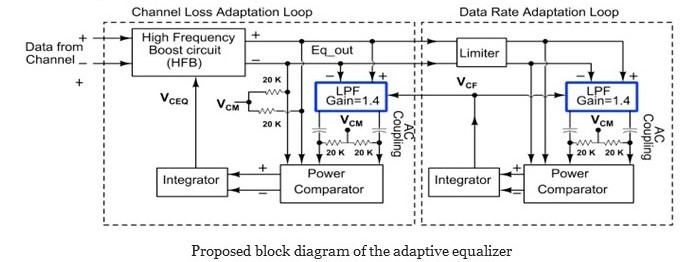This invention introduces an adaptive equalizer designed to improve how data is transmitted over communication channels. It addresses issues like signal distortion and interference that occur during high-speed data transmission. By automatically adjusting to different data rates and effectively compensating for these challenges without requiring complex filters, the equalizer enhances the reliability and efficiency of communication systems. It helps maintain signal clarity and ensures that data is transmitted accurately across various applications and environments.
The problem with current communication systems lies in the interference and signal degradation caused by channel losses and distortion, particularly in high-speed data transmission scenarios. These challenges lead to errors and reduced data rates due to overlapping symbols and frequency distortions within the transmission channel. To tackle this, the adaptive equalizer introduced in this invention adjusts dynamically to varying data rates while compensating for Inter Symbol Interference (ISI). By incorporating advanced control mechanisms and innovative spectral balancing techniques, it effectively mitigates these issues without relying on complex High Pass Filters (HPFs), thereby optimizing signal integrity, reducing power consumption, and simplifying circuit design for more reliable communication performance across different applications.
- Dynamic Adaptation: This innovation automatically adjusts to varying data rates, enhancing flexibility in communication systems.
- Spectral Balancing: It achieves effective channel equalization without the need for complex HPFs, reducing circuit complexity.
- Power Efficiency: It minimizes power consumption by eliminating HPFs traditionally used for frequency compensation.
- ISI Mitigation: It effectively compensates for ISI caused by channel losses and distortion.
- Enhanced Performance: It improves signal integrity and data transmission rates across diverse communication environments.
Test chip is fabricated in 180nm CMOS technology and tested in the lab.
4
This technology improves reliability and speed of data transmission in critical applications like telecommunications and aerospace, enhancing overall efficiency. It enables advancements in communication technology that can benefit industries reliant on high-speed data transfer, potentially leading to better services and products for consumers.
- Telecommunications: To enhance data transmission over long distances and through complex channels
- Aerospace and Defense: Applied in aerospace for reliable communication systems that operate in challenging environments like airborne and space missions
- Other Sectors: Information Technology, Automotive
Geography of IP
Type of IP
201621016639
522921

